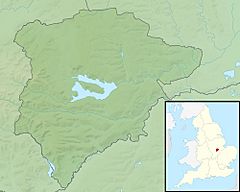Morcott Brook facts for kids
Quick facts for kids Morcott Brook |
|
|---|---|

The Morcott Brook between Glaston and Morcott
|
|
|
Location of the river mouth in Rutland
|
|
| Country | England |
| County | Rutland |
| Physical characteristics | |
| Main source | Ridlington, Rutland 152 m (499 ft) 52°36′40″N 0°45′13″W / 52.611053°N 0.753478°W |
| River mouth | River Chater South Luffenham, Rutland 49 m (161 ft) 52°36′48″N 0°36′35″W / 52.613292°N 0.609722°W |
| Length | 12.2 km (7.6 mi) |
| Basin features | |
| River system | River Welland |
| Basin size | 20.9 km2 (8.1 sq mi) |
The Morcott Brook is a small river in Rutland, England. People sometimes call it "The Foss". It's a branch, or tributary, of the River Chater. The Morcott Brook is also part of a larger river system called the River Welland.
Where Does the Morcott Brook Flow?
The Morcott Brook starts its journey near a village called Ridlington. From there, it flows mostly towards the east. It travels through a narrow valley.
Along its path, the brook passes by several places. These include Ayston, and it flows between Glaston and Wing. Near Wing, a smaller, unnamed stream joins the Morcott Brook. This small stream starts near Preston.
The brook continues its eastward flow. It goes north of Morcott village. Here, it makes a sharp turn and heads towards the north-east. It then flows right through the middle of South Luffenham.
After leaving South Luffenham, the brook goes under the Birmingham to Peterborough Railway Line. Soon after, it meets and joins the River Chater. This meeting point is close to where the old Luffenham railway station used to be.
How Healthy is the Morcott Brook?
In 2016, experts checked the Morcott Brook's health. They used something called the Water Framework Directive. This is a way to measure how clean and natural rivers are.
Unfortunately, the Morcott Brook was rated as 'Bad'. This means it needs some help to become healthier. There were a few reasons for this rating:
- Changes to the River: The brook has been changed by people. These changes, like artificial barriers, can make it hard for fish to move freely.
- Farm Management: Sometimes, the way farms are managed nearby can affect the water. Things like too many nutrients from fields can get into the brook.
- Water Discharges: Treated water from homes and businesses can also flow into the river. Even though it's treated, it can still impact the river's quality.
These issues show that the brook needs care. Improving its health helps all the plants and animals that live in and around the water.


